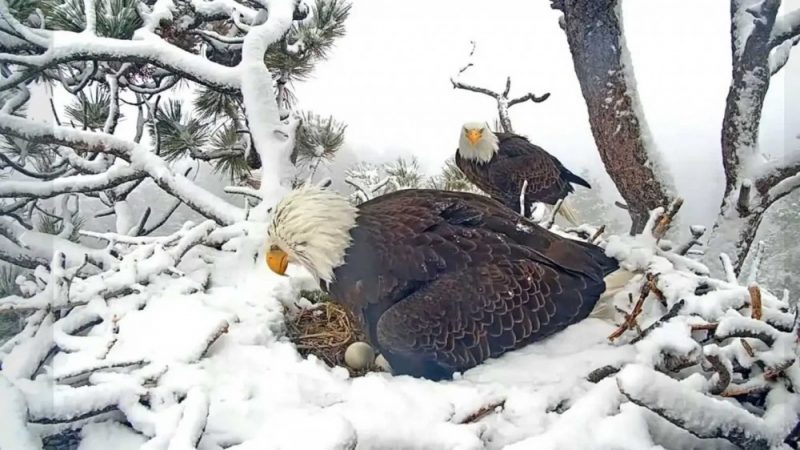Sadly, these live-streamed bald eagle eggs likely won’t hatch

Though they’ve captivated the internet since late February, three eagle eggs in a nest in Southern California are unlikely to hatch. Parents Jakie and Shadow continue to take turns keeping the eggs warm, as snow dots their nest overlooking Big Bear Lake in the San Bernardino Mountains.
“At this point, from the date that the eggs were laid, it’s past the time that Jackie’s eggs have hatched in the past,” biologist and nonprofit Friends of Big Bear Valley executive director Sandy Steers tells PopSci. “It’s not past the time that any eagle eggs have hatched. So there’s still a small window, but it’s diminishing quickly.”

Friends of Big Bear Valley/Big Bear Eagle Nest Cam
According to the US Fish & Wildlife Service, it typically takes eagle eggs about 35 days to hatch. The first egg was laid on January 25, so the earliest the hatching would have been on February 29 and all three eggs should have hatched by now. A three-egg clutch like this is rare for bald eagles and is a first for Jackie. Only about 50 percent of eagle eggs hatch.
[Related: Watch: Three bald eagles could hatch any day now.]
Weather, altitude, and biology
“It could be that the temperatures we had during the incubation period, and when they were laid, were not that good. It could be the amount of oxygen. We’re at a very high altitude, higher than most eagle’s nests, so we have low oxygen levels to begin with,” says Steers. “We also had those big storms. It could also be something biological that just was off when the eggs were created, or during the development process. We just don’t know.”
In previous years, Jackie has left the eggs alone sooner, but this year, Shadow fills in as needed. Jackie and Shadow have had one chick in 2019 and one in 2022, but lost two eggs last year. In the coming days and weeks, they will likely start to spend less time sitting on the eggs. Eventually, the eggs will either be buried into the nest under sticks and twigs or could be taken by a predator like a raven.
Connecting with thousands viewers
The viral livestream of the nest has consistently been clocking in over 20,000 viewers per day, as intense blizzards and fierce winds have spread across the valley. Many viewers have expressed sadness that the eggs will likely not hatch and worry what this means for the pair. According to Steers, this does not tell us much about their future and has given the public some important life lessons from nature.
[Related: Thriving baby California condor is a ray of hope for the unique species.]
“Jackie and Shadow take every day as it comes and they deal with what’s in front of them. I think watching nature and learning from nature as to, it’s okay to have reactions,” says Steers.
As for the eagle pair, Steers says, “We don’t know that they’re feeling exactly what we’re feeling, but they change their behavior in very distinct ways, based on what’s going on. They’re resilient; they move on.”
The nest cameras will remain on 24/7, so viewers will be able to tune in to see what changes as spring settles into the valley. The nonprofit also keeps a blog with daily updates about the nest.










